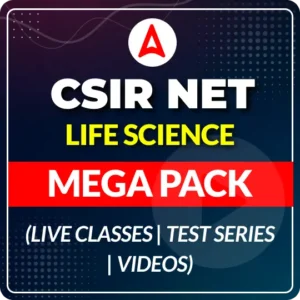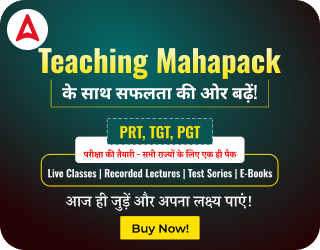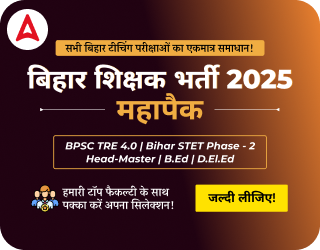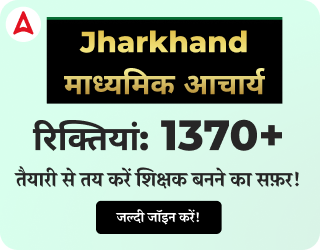Table of Contents
The NVS is the national-level recruitment exam conducted by the Navodaya Vidyalaya Samiti (NVS). The NVS Application Process 2022 ended in July 2022. The NVS Exam Date 2022 will be released soon. The candidates need to prepare for the NVS Exam 2022 diligently to be able to crack the NVS Exam 2022. They must clearly understand the syllabus and exam pattern of the NVS Exam 2022 to be able to crack the exam.
The candidates must prepare for subjects such as Reasoning, General Awareness, ICT, Teaching Aptitude and Languages to excel in the NVS exam. In this article, we are sharing high-quality General Knowledge Questions for NVS Exam. These General Knowledge Questions for NVS Exam have been curated by our expert faculty and subject matter experts, especially for the NVS Exam 2022. Go through the article carefully to find out the General Knowledge Questions for NVS Exam, solve them and crosscheck your answer with the correct solution given below.
General Knowledge Questions for NVS Exam & Exam Pattern
The candidates must refer to the following NVS Exam Pattern for various posts. This will help them comprehend the intricacies of the NVS Exam Pattern 2022. Moreover, they should keep a look at the weightage of marks of the General Knowledge to understand its importance in cracking the NVS Exam 2022. As NVS has released vacancies for the post of TGT, PGT and Principal, you will find the NVS Exam Pattern for these three posts.
Exam Pattern For the post of Principal
| Section | Component of the test | Number of Questions | Total Marks | Duration |
| Part-I | Reasoning & Numeric Ability | 10 | 10 | The test will be of 3 hours duration without any time limit for each test individually. |
| Part-II | General Awareness | 20 | 20 | |
| Part-III | Language Competency Test (General English -10 , General Hindi -10) | 20 | 20 | |
| Part-IV | Academic and residential aspects | 50 | 50 | |
| Part-V | Administration and Finance | 50 | 50 | |
| Total | 150 | 150 |
Exam Pattern For the post of PGTs:
| Section | Component of the test | Number of Questions | Total Marks | Duration |
| Part-I | General Awareness | 10 | 10 | The test will be of 3 hours duration without any time limit for each test individually. |
| Part-II | Reasoning Ability | 20 | 20 | |
| Part-III | Knowledge of ICT | 10 | 10 | |
| Part-IV | Teaching Aptitude | 10 | 10 | |
| Part-V | Subject Concerned and its Pedagogy | 80 | 80 | |
| Part – VI | Language Competency Test (General English -10 , General Hindi -10) | 20 | 20 | |
| Total | 150 | 150 |
Exam Pattern For the post of TGTs & TGT Misc.
| Section | Component of the test | Number of Questions | Total Marks | Duration |
| Part-I | General Awareness | 10 | 10 | The test will be of 3 hours duration without any time limit for each test individually. |
| Part-II | Reasoning Ability | 10 | 10 | |
| Part-III | Knowledge of ICT | 10 | 10 | |
| Part-IV | Teaching Aptitude | 10 | 10 | |
| Part-V | Subject Concerned and its Pedagogy | 80 | 80 | |
| Part – VI | Language Competency Test (General English -10 , General Hindi -10, Regional Language- 10) | 30 | 30 | |
| Total | 150 | 150 |
General Knowledge Questions for NVS Exam
Check out the NVS GK Questions given in the following section. The candidates can easily attempt the following questions from the General Knowledge section and prepare for the NVS Exam 2022. They can access the full NVS General Knowledge Question PDF which contains 250 questions from the link given below.
Q1. The official language of the Delhi Sultanate was?
(a) Urdu
(b) Arabic
(c) Persian
(d) Hindi
Q2. What was the immediate aim of the Treaty of Purander in 1665?
(a) To gain goodwill of Shivaji
(b) To sow seeds of contention between Shivaji and Sultan of Bijapur
(c) To deceive Shivaji
(d) To make Shivaji a puppet of Mughals
Q3.Who is the founder of the city of Agra?
(a) Akbar
(b) Babar
(c) Sikandar Lodi
(d) Mubarak Shah Sayyad
Q4. What were the smallest unit called in the Vijayanagar Empire?
(a) Nadu
(b) Khurram
(c) Kampana
(d) Janpad
Q5.In 1617 the British East India Company was given permission by __________ to trade in India.
(a) Babur
(b) Akbar
(c) Aurangzeb
(d) Jahangir
Q6. The decision to effect the Partition of Bengal was announced in 1905 by?
(a) Lord William Bentinck
(b) Lord Mountbatten
(c) Warren Hastings
(d) Lord Curzon
Q7. Who is referred to as ‘Frontier Gandhi’?
(a) Sheikh Abdullah
(b) Manilal Gandhi
(c) Khan Abdul Gaffar Khan
(d) Gopal Krishna Gokhale
Q8. Who was the first Indian Governor General of Independent India?
(a) Rajendra Prasad
(b) C. Rajagopalachari
(c) A. Kriplani
(d) Lord Mountbatten
Q9. Gandhiji’s first Satyagraha in India was held at __________.
(a) Champaran
(b) Ahmedabad
(c) Kheda
(d) Allahabad
Q10. As a prince where was Ashoka sent to suppress the revolt?
(a) Taxila
(b) Kalinga
(c) Ujjain
(d) Deccan
Q11. The Hathigumpha inscription near Bhubaneshwar, Orissa relates to the king?
(a) Susharma
(b) Hala
(c) Kharavela
(d) Pulamayi
Q12. The main historical source regarding the information about Self-government under the Cholas is the?
(a) Halmidi inscription
(b) Jatwai inscription
(c) Uttaramerur inscription
(d) Chandravallo inscription
Q13. Megasthenes was at the court of
(a) Kanishka
(b) Ashoka
(c) Chandragupta Maurya
(d) Harsha
Q14. The Sikh Guru who fought in the Mughal ranks during the reign of Aurangazeb was
(a) Guru Tegh Bahadur
(b) Guru Har Rai
(c) Guru Amar Das
(d) Guru Angad
Q15. Under the Mughals, in urban area the judicial powers were exercised by
(a) Kazis
(b) Faujdar
(c) Kotwal
(d) Wazir
Q16. Under the Mughals _________________ was administered as a department of the military
(a) Diwan-i-insha
(b) Diwan-i-Wazarat
(c) Diwan-i-Arz
(d) Diwan-i-Barid
Q17. Akbar defeated Durgawati and captured
(a) Bijapur
(b) Jhansi
(c) Gondwana
(d) Surat
Q18. In which of the following movements Vande Mataram was adopted slogan for agitation?
(a) Revolt of 1857
(b) Partition of Bengal in 1905
(c) Non Co–operation Movement in 1922
(d) Quit India Movement in 1942
Q19. What was the immediate cause for the launch of the Swadeshi Movement?
(a) The partiton of Bengal done by Lord Curzon
(b) A sentence of 18 months rigorous imprisonment imposed on Lokmanya Tilak
(c) The arrest and deportation of Lala Lajpat Rai and Ajit Singh; and passing of the Punjab Colonization Bill.
(d) Death sentence pronounced on the Chapkar brothers
Q20. Who among the following estimated Indian National Income and criticized the constant drain of wealth from India to England?
(a) Gandhiji
(b) Gokhale
(c) Dadabhai Naoroji
(d) Bal Gangadhar Tilak
Q21. Which book was written by Dadabhai Naoroji on Indian poverty and economy under British rule?
(a)Indian Economy under British rule?
(b)British Rule and Economic Drain of India
(c)Poverty and Un-British Rule in India
(d)Economic Drain and Poverty of India
Q22.The only session of the Indian National Congress which was presided over by Mahatma Gandhi was
(a) Amravati
(b) Belgaum
(c) Karachi
(d) Nagpur
Q23. Who wrote ‘Ashtadhyayi’, the earliest existing grammar of Sanskrit?
(a) Panini
(b) Sushruta
(c) Patanjali
(d) Charak
Q24. The Lilavati was a treatise on
(a) Arithmetic
(b) Astronomy
(c) Philosophy
(d) Medicine
Q25. Kakori conspiracy case took place in the year
(a) 1920
(b) 1924
(c) 1925
(d) 1935
Solution of General Knowledge Questions for NVS Exam
S1. Ans.(c)
Sol. The official language of Delhi Sultanate was Persian.
S2. Ans.(b)
Sol. The Treaty of Purandar was signed between Chhatrapati Shivaji Maharaj and Raja Jai Singh (on behalf of Mughal Emperor Aurangzeb).There were some secret clauses in the treaty as well, which provided for Shivaji’s participation in the war against Bijapur on behalf of the Emperor.
S3. Ans.(c)
Sol. It is generally accepted that Sultan Sikandar Lodī, the Muslim ruler of the Delhi Sultanate, founded Agra in the year 1504. After the Sultan’s death, the city passed on to his son, Sultan Ibrāhīm Lodī.
S4. Ans.(c)
Sol. In the Vijayanagar Empire a Rajya was divided into regions (Vishaya Vente or Kottam) and further divided into counties (Sime or Nadu), themselves subdivided into municipalities (Kampana or Sthala).
S5. Ans.(d)
Sol. In 1617 the British East India Company was given permission by Jahangir to trade in India.
S6. Ans.(d)
Sol. . The decision to effect the Partition of Bengal was announced in 1905 by Lord Curzon.
S7. Ans.(c)
Sol. Khan Abdul Gaffar Khan is also known as Frontier Gandhi.
S8. Ans.(b)
Sol. C. Rajagopalachari (Rajaji) served as the first and the only Indian governor general of India .
S9. Ans.(a)
Sol. Gandhi, the exponent of the Satyagraha movement, staged his first Satyagraha in Champaran, in Bihar in 1917.
S10. Ans.(a)
Sol. Taxila was an ancient city in what is now northwestern Pakistan. It is an important archaeological site and in 1980, was declared a UNESCO World Heritage Site.Taxila came under the control of Chandragupta Maurya, who turned Taxila into a regional capital.Taxila is famous for oldest university in the world.
S11. Ans.(c)
Sol. The Hathigumpha Inscription, from Udayagiri, near Bhubaneswar in Odisha, was inscribed by Kharavela, the then Emperor of Kalinga in India, during 2nd century BCE.
S12. Ans.(c)
Sol. The temple inscriptions of Uthiramerur are notable for their historical descriptions of the rural self-governance. They indicate that Uthiramerur had two village assemblies: Sabha and Ur. Chola administration is famous for its local government.
S13. Ans.(c)
Sol. Megasthenes was born in Asia Minor and became an ambassador of Seleucus I Nicator of the Seleucid dynasty to Chandragupta Maurya in Pataliputra, India. Indica is an account of Mauryan India by Megasthenes.
S14. Ans.(a)
Sol. Guru Tegh Bahadur was the ninth of ten Gurus of the Sikh religion. He was publicly beheaded in 1675 on the orders of Mughal emperor Aurangzeb in Delhi for refusing to convert to Islam.
S15. Ans.(c)
Sol. Kotwals was a title used in medieval India for the leader of the fort. Kotwals often controlled the fort of a major town or an area of smaller towns on behalf of another ruler. It was similar in function to a British India Zaildar.
S16. Ans.(c)
Sol. Diwan-i-Arz was a department of the military.
S17. Ans.(c)
Sol. Rani Durgavati was a ruling Queen of Gondwana from 1550 until 1564. She was born in the family of famous Rajput Chandel Emperor Keerat Rai.
S18. Ans.(b)
Sol. A poem from Bankim Chandra Chattopahyay’s novel Anandmath in 1882, written in Bengali and Sanskrit to praise the motherland, it has played a vital role in partion of Bengal movement. Vande Mataram was adopted slogan for agitation in Partition of Bengal in 1905.
S19. Ans.(a)
Sol. The Swadeshi movement, part of the Indian independence movement and the developing Indian nationalism, was an economic strategy aimed at removing the British Empire from power and improving economic conditions in India by following the principles of Swadeshi and which had some success. The partiton of Bengal done by Lord Curzon is cause for the launch of the Swadeshi Movement.
S20. Ans.(c)
Sol. Dadabhai Naoroji prepared the first estimates of National income in 1876. He estimated the national income by first estimating the value of agricultural production and then adding a certain percentage as non-agricultural production Dadabhai Naoroji put forward the ‘drain of wealth’ theory in which he stated that the Britain was completely draining India. He mentioned this theory in his book Poverty and Un-British Rule in India.
S21. Ans.(c)
Sol. Naoroji published Poverty and un-British Rule in India in 1901. Dadabhai Naoroji’s work focused on the drain of wealth from India into England during colonial rule of British in India.
S22. Ans.(b)
Sol. Belgaum is the only session of the Indian National Congress which was presided over by Mahatma Gandhi in 1924.
S23. Ans.(a)
Sol. Panini, is the name of an ancient Sanskrit linguist, grammarian, and a revered scholar in Hinduism. He is known for his text Ashtadhyayi, a sutra-style treatise on Sanskrit grammar, estimated to have been completed between 6th and 4th century BCE.
S24. Ans.(a)
Sol. The Lilavatiis Indian mathematician Bhāskara II’s treatise on mathematics, written in 1150AD. It is the first volume of his main work, the Siddhānta Shiromani, alongside the Bijaganita, the Grahaganita and the Golādhyāya.
S25. Ans.(c)
Sol. The Kakori Conspiracy was a train robbery that took place between Kakori and, near Lucknow, on 9 August 1925 during the Indian Independence Movement against the British Indian Government.
General Knowledge Questions for NVS Exam
Here are the General Knowledge Questions for NVS Exam PDF in the following. The candidates will have to click on the link given below to access the General Knowledge Questions for NVS Exam PDF.
General Knowledge Questions for NVS Exam
| Important Links | |
| NVS 2022 Exam | NVS Syllabus 2022 |
| NVS Previous Year Paper | NVS Vacancy |
| NVS Selection Process | NVS Teacher Salary |
| NVS Eligibility Criteria | How to Prepare NVS? |




 Odisha LTR Question Paper 2025, Check Su...
Odisha LTR Question Paper 2025, Check Su...
 HPSC Assistant Professor Final Answer Ke...
HPSC Assistant Professor Final Answer Ke...
 HPSC Assistant Professor Question Paper ...
HPSC Assistant Professor Question Paper ...




